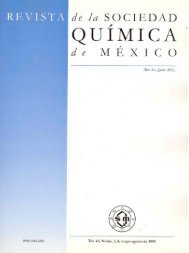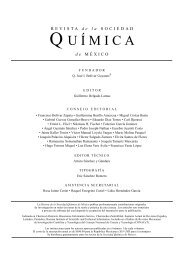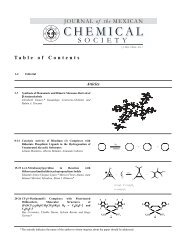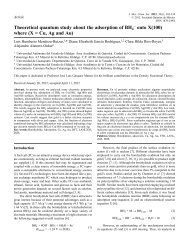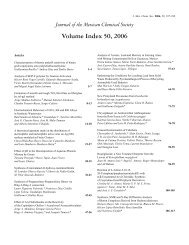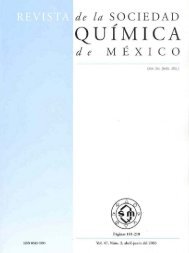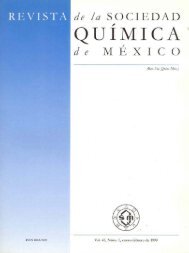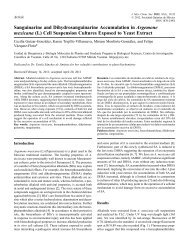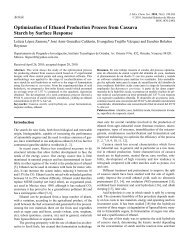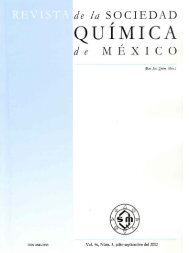Identification of Anthocyanins in Red Grape, Plum and Capulin by ...
Identification of Anthocyanins in Red Grape, Plum and Capulin by ...
Identification of Anthocyanins in Red Grape, Plum and Capulin by ...
Create successful ePaper yourself
Turn your PDF publications into a flip-book with our unique Google optimized e-Paper software.
J. Mex. Chem. Soc. 2012, 56(4), 378-383<br />
378<br />
Article<br />
J. Mex. Chem. Soc. 2012, 56(4)<br />
© 2012,<br />
Araceli<br />
Sociedad<br />
Castañeda-Ov<strong>and</strong>o<br />
Química de México<br />
et al.<br />
ISSN 1870-249X<br />
<strong>Identification</strong> <strong>of</strong> <strong>Anthocyan<strong>in</strong>s</strong> <strong>in</strong> <strong>Red</strong> <strong>Grape</strong>, <strong>Plum</strong> <strong>and</strong> Capul<strong>in</strong><br />
<strong>by</strong> MALDI-ToF MS<br />
Araceli Castañeda-Ov<strong>and</strong>o, 1 * Ondra Sedo, 2 Josef Havel, 2 Lourdes Pacheco, 1 Carlos Andrés Galán-Vidal, 1<br />
<strong>and</strong> Elizabeth Contreras López 1<br />
1<br />
Área Académica de Química. Universidad Autónoma del Estado de Hidalgo, Carr. Pachuca-Tulanc<strong>in</strong>go, km 4.5 M<strong>in</strong>eral de la<br />
Reforma, Hidalgo, México. ov<strong>and</strong>oa@uaeh.edu.mx<br />
2<br />
Analytical Chemistry Department, Masaryk University, Kotlarska 2, 611 37, Brno, Czech Republic<br />
Received December 6, 2011; Accepted June 15, 2012<br />
Abstract. A simple <strong>and</strong> fast method was developed to identify anthocyan<strong>in</strong>s<br />
<strong>in</strong> red grapes, plums <strong>and</strong> capul<strong>in</strong>s <strong>by</strong> MALDI-ToF MS. Three<br />
different matrices were used: α-CHCA (α-cyano-4-hydroxyc<strong>in</strong>namic<br />
acid), THA (2’,4’,6’-trihydroxyacetophenone) <strong>and</strong> DHBA (2,5-dihydroxybenzoic<br />
acid). Post-Source Decay (PSD) fragment detection allowed<br />
study<strong>in</strong>g the structure <strong>of</strong> compounds detected. Deprotonated<br />
anthocyan<strong>in</strong> species were assigned <strong>in</strong> capul<strong>in</strong> ([Cyanid<strong>in</strong>-3-glucosidedeprotonated]K<br />
+ <strong>and</strong> [Cyanid<strong>in</strong>-3-rut<strong>in</strong>oside-deprotonated]K + ), due to<br />
these compounds also can be ionized <strong>in</strong> form <strong>of</strong> potassium adducts<br />
comb<strong>in</strong>ed with a deprotonation.<br />
Key words: MALDI-ToF MS, <strong>Grape</strong>s, <strong>Plum</strong>s, Capul<strong>in</strong>s, Deprotonated<br />
<strong>Anthocyan<strong>in</strong>s</strong>.<br />
Resumen. Se desarrolló un método simple y rápido para identificar<br />
antocian<strong>in</strong>as en uvas rojas, ciruelas y capul<strong>in</strong>es por MALDI-ToF MS.<br />
Se utilizaron tres matrices diferentes: α-CHCA (ácido α-ciano-4-hidroxic<strong>in</strong>ámico),<br />
THA (2’,4’,6’-trihidroxiacet<strong>of</strong>enona) y DHBA (ácido<br />
2,5-dihidroxibenzoico. La detección del fragmento por Decaimiento<br />
Post-Fuente (PSD) permitió el estudió de los compuestos detectados.<br />
En el capulín se asignaron especies desprotonadas de antocian<strong>in</strong>as ([3-<br />
glucósido-de cianid<strong>in</strong>a desprotonada]K + y [3-rut<strong>in</strong>ósido de cianid<strong>in</strong>a<br />
desprotonada]K + ) ya que estos compuestos también pueden ionizarse<br />
en forma de aductos de potasio comb<strong>in</strong>ados con una desprotonación.<br />
Palabras clave: MALDI-ToF MS, uvas, ciruelas, capul<strong>in</strong>es, antocian<strong>in</strong>as<br />
desprotonadas.<br />
Introduction<br />
<strong>Anthocyan<strong>in</strong>s</strong> are an important group <strong>of</strong> natural dyes, which<br />
belong to a larger class <strong>of</strong> plant chemicals known as flavonoids<br />
<strong>and</strong> are compounds with two aromatic r<strong>in</strong>gs, bound <strong>by</strong><br />
a structure <strong>of</strong> three carbons <strong>and</strong> substituted with one or two<br />
sugar moieties. In Table 1 are shown the most frequent anthocyanid<strong>in</strong>s<br />
(aglycons), <strong>and</strong> when R 1 is a sugar fraction (with or<br />
without acylated substitution) they are anthocyan<strong>in</strong>s.<br />
Models <strong>of</strong> anthocyanic pigments exhibited for the different<br />
species <strong>of</strong> fruits have demonstrated to be <strong>in</strong>terest<strong>in</strong>g for the<br />
chemotaxonomic researchers <strong>and</strong> nowadays they are frequently<br />
used for the control <strong>of</strong> mixtures or juices adulteration [1]. Additionally,<br />
the beneficial health effects <strong>and</strong> antioxidant properties<br />
[2, 3] <strong>of</strong> anthocyan<strong>in</strong>s have generated a big <strong>in</strong>terest <strong>in</strong> the<br />
research <strong>of</strong> anthocyan<strong>in</strong>s dur<strong>in</strong>g the last decade [2].<br />
<strong>Anthocyan<strong>in</strong>s</strong> represent the ma<strong>in</strong> water soluble pigments,<br />
they are directly responsible <strong>of</strong> the sh<strong>in</strong>y orange, p<strong>in</strong>k, red,<br />
Table 1. Structural identification <strong>of</strong> the most common anthocyanid<strong>in</strong>s (aglycons).<br />
R 5<br />
3'<br />
1 2'<br />
8<br />
B<br />
R 4 7<br />
O 2 1'<br />
A C<br />
6'<br />
3<br />
R 3<br />
5<br />
R<br />
4<br />
1<br />
R 2<br />
5'<br />
4'<br />
R 6<br />
R 7<br />
General anthocyan<strong>in</strong>s structure<br />
Name Abbreviation R 1 R 2 R 3 R 4 R 5 R 6 R 7<br />
Cyanid<strong>in</strong> Cy OH OH H OH OH OH H<br />
Delph<strong>in</strong>id<strong>in</strong> Dp OH OH H OH OH OH OH<br />
Malvid<strong>in</strong> Mv OH OH H OH OMe OH OMe<br />
Pelargonid<strong>in</strong> Pg OH OH H OH H OH H<br />
Peonid<strong>in</strong> Pn OH OH H OH OMe OH H<br />
Petunid<strong>in</strong> Pt OH OH H OH OMe OH OH
<strong>Identification</strong> <strong>of</strong> <strong>Anthocyan<strong>in</strong>s</strong> <strong>in</strong> <strong>Red</strong> <strong>Grape</strong>, <strong>Plum</strong> <strong>and</strong> Capul<strong>in</strong> <strong>by</strong> MALDI-ToF MS 379<br />
magenta, violet <strong>and</strong> blue colors <strong>in</strong> the flower petals, <strong>in</strong> fruits<br />
as strawberries, capul<strong>in</strong>, plums, grapes, apples, cherries, <strong>and</strong><br />
grasses [4, 5]. Anthocyanic content for red grape, plum <strong>and</strong><br />
capul<strong>in</strong> is shown <strong>in</strong> Table 2.<br />
Mass Spectrometry is an analytical method used for anthocyan<strong>in</strong>s<br />
identification, especially t<strong>and</strong>em with separation systems,<br />
such as liquid chromatography (LC), gas chromatography<br />
(GC) <strong>and</strong> capillary electrophoresis (CE).<br />
Several ionization methods <strong>by</strong> desorption have developed<br />
<strong>in</strong> the two last decades, they used for non volatile or thermodynamically<br />
unstable samples, for example, the anthocyan<strong>in</strong>s.<br />
These techniques dispense with volatilization <strong>and</strong> subsequent<br />
ionization, <strong>in</strong>stead supplies power to solid or liquid sample <strong>in</strong><br />
different ways, so that causes the direct formation <strong>of</strong> gaseous<br />
ions; obta<strong>in</strong><strong>in</strong>g simplified mass spectra.<br />
Among these desorption sources are fast-atom bombardment<br />
(FAB), desorption electrospray ionization (DESI) <strong>and</strong><br />
Matrix-assisted laser desorption ionization (MALDI), which<br />
are considered s<strong>of</strong>t ionization sources, because they give rise<br />
to little fragmentation, provid<strong>in</strong>g useful <strong>in</strong>formation that allows<br />
accurate molecular weight determ<strong>in</strong>ation <strong>of</strong> the molecule or<br />
molecules.<br />
With respect to the use <strong>of</strong> Matrix-assisted laser desorption<br />
ionization-time <strong>of</strong> flight mass spectrometry (MALDI-ToF<br />
MS) for the anthocyan<strong>in</strong>s analysis, speed <strong>of</strong> the analysis (approximately<br />
4 m<strong>in</strong>utes per sample) has been found as a ma<strong>in</strong><br />
advantage [15].<br />
Therefore, <strong>in</strong> this study was carried out the anthocyan<strong>in</strong>s<br />
extraction from red grapes (Vitis v<strong>in</strong>ifera), plums (Prunus domestica)<br />
<strong>and</strong> capul<strong>in</strong>s (Prunus serot<strong>in</strong>a); <strong>and</strong> were identified <strong>by</strong><br />
the technique <strong>of</strong> MALDI-ToF MS with the purpose <strong>of</strong> develop<strong>in</strong>g<br />
a fast procedure to analyze these compounds.<br />
Results <strong>and</strong> discussion<br />
Matrix selection<br />
All extracts were analyzed <strong>by</strong> MALDI-ToF MS us<strong>in</strong>g three<br />
different matrices. Besides previously proposed matrix THA,<br />
which was found to give good spot-to-spot repeatability for<br />
anthocyan<strong>in</strong> signals <strong>in</strong> w<strong>in</strong>e extracts [16], α-CHCA was selected<br />
as a matrix known for high ionization sensitivity <strong>and</strong><br />
DHBA as a universal matrix capable to ionize various classes<br />
<strong>of</strong> compounds. The ability <strong>of</strong> the <strong>in</strong>strumentation to perform<br />
Post-Source Decay (PSD) fragment detection allowed to study<br />
the structure <strong>of</strong> compounds detected.<br />
As the optimal matrix, α-CHCA was selected yield<strong>in</strong>g 10-<br />
fold higher signals <strong>of</strong> the analytes than DHBA or THA. Molecular<br />
weights <strong>of</strong> the compounds seen from the mass spectra<br />
correspond to a variety <strong>of</strong> anthocyan<strong>in</strong> derivatives.<br />
Figure 1 shows mass spectra <strong>of</strong> the red grapes extract<br />
with three matrices used <strong>in</strong> the analysis (α-CHCA, DHBA <strong>and</strong><br />
THA); the best signals were obta<strong>in</strong>ed with α-CHCA matrix, <strong>and</strong><br />
THA gave lower signal <strong>in</strong>tensities.<br />
%Intensity<br />
%Intensity<br />
%Intensity<br />
100<br />
M<br />
M<br />
80<br />
M<br />
60<br />
M S<br />
S<br />
40<br />
M<br />
20 M S<br />
S<br />
0<br />
S<br />
200 250 300 350 400 450 500<br />
mass/charge<br />
100<br />
MM<br />
80<br />
60<br />
M<br />
40<br />
20<br />
S<br />
S<br />
0<br />
200 250 300 350 400 450 500<br />
mass/charge<br />
100<br />
M<br />
80<br />
M<br />
60<br />
M<br />
40<br />
M<br />
20<br />
0<br />
S<br />
S<br />
200 250 300 350 400 450 500<br />
mass/charge<br />
550<br />
550<br />
550<br />
S<br />
S S<br />
600 650<br />
Fig. 1. MALDI-ToF mass spectra <strong>of</strong> red grapes extract obta<strong>in</strong>ed <strong>in</strong><br />
reflectron positive mode with pulsed extraction, laser power <strong>of</strong> 2.83<br />
mW, <strong>and</strong> as matrix: (A) α-CHCA, (B) DHBA, <strong>and</strong> (C) THA. Where:<br />
M, signal for matrix; <strong>and</strong> S, signal for sample.<br />
S<br />
600<br />
600<br />
650<br />
650<br />
(A)<br />
(B)<br />
(C)<br />
700<br />
700<br />
700<br />
Table 2. Anthocyanic content <strong>in</strong> red grape, plum <strong>and</strong> capul<strong>in</strong>.<br />
Fruit<br />
<strong>Anthocyan<strong>in</strong>s</strong><br />
<strong>Red</strong> grape 3-glucoside (Delph<strong>in</strong>id<strong>in</strong>, Cyanid<strong>in</strong>, Peonid<strong>in</strong>, Malvid<strong>in</strong>) [4,5-11]<br />
3-acetil-glucoside (Malvid<strong>in</strong>, Delph<strong>in</strong>id<strong>in</strong>, Petunid<strong>in</strong>, Peonid<strong>in</strong>, Cyanid<strong>in</strong>)<br />
<strong>and</strong> 3-coumaril-glucoside (Malvid<strong>in</strong>, Delph<strong>in</strong>id<strong>in</strong>, Cyanid<strong>in</strong>, Petunid<strong>in</strong>, Peonid<strong>in</strong>) [7-10]<br />
3,5-diglucoside (Delph<strong>in</strong>id<strong>in</strong>, Petunid<strong>in</strong>) [8]<br />
3-caffeoyl-glucoside (Peonid<strong>in</strong>, Malvid<strong>in</strong>) [8,9]<br />
<strong>Plum</strong> Cyanid<strong>in</strong>-3-sophoroside [4]<br />
Cyanid<strong>in</strong> (3-glucoside, 3-rut<strong>in</strong>oside) [12,13]<br />
Peonid<strong>in</strong> (3-glucoside, 3-rut<strong>in</strong>oside) [13]<br />
Capul<strong>in</strong> Cyanid<strong>in</strong>-3-glucoside, Cyanid<strong>in</strong>-3-rut<strong>in</strong>oside [14]
380 J. Mex. Chem. Soc. 2012, 56(4) Araceli Castañeda-Ov<strong>and</strong>o et al.<br />
<strong>Red</strong> grapes<br />
The spectrum from red grapes, us<strong>in</strong>g α-CHCA as matrix, is<br />
shown <strong>in</strong> Figure 2, signals were found at the m/z values: 212.0,<br />
227.9, 249.8, 277.1, <strong>and</strong> 288.1 (α-CHCA matrix cluster), 301.1<br />
(Peonid<strong>in</strong>), 331.2 (Malvid<strong>in</strong>), 463.1 (Peonid<strong>in</strong>-3-glucoside),<br />
479.1 (Petunid<strong>in</strong>-3-glucoside), 492.8 (Malvid<strong>in</strong>-3-glucoside),<br />
609.2 (Peonid<strong>in</strong>-3-glucoside-p-coumarate), 625.2 (Peonid<strong>in</strong>-<br />
3,5-diglucoside), <strong>and</strong> 639.3 (Malvid<strong>in</strong>-3-glucoside-p-coumarate).<br />
The last identification was obta<strong>in</strong>ed <strong>by</strong> PSD <strong>of</strong> all <strong>of</strong> the<br />
compounds, which was carried out with <strong>in</strong>creased laser power<br />
<strong>and</strong> ion gate set to the correspond<strong>in</strong>g masses. Table 3 shows<br />
the ma<strong>in</strong> compounds with their respective MALDI mass <strong>and</strong><br />
PSD fragment mass.<br />
The most common anthocyan<strong>in</strong>s <strong>in</strong> red grapes are acylated,<br />
this is the reason <strong>of</strong> the red w<strong>in</strong>e stability which comes from a<br />
comb<strong>in</strong>ation <strong>of</strong> diverse factors such as: structure, concentration,<br />
pH, temperature <strong>and</strong> the presence <strong>of</strong> complex<strong>in</strong>g agents [17].<br />
One <strong>of</strong> the PSD spectra (from Peonid<strong>in</strong>-3-glucoside-p-coumarate)<br />
is displayed <strong>in</strong> Figure 3, where, beside the precursor<br />
ion, only one <strong>in</strong>tense signal can be observed. The peak results<br />
from the cleavage <strong>of</strong> glycosidic bond, which was found to be<br />
characteristic for all anthocyan<strong>in</strong> derivatives. Such fragment<br />
monitor<strong>in</strong>g significantly facilitates the identification <strong>of</strong> this<br />
class <strong>of</strong> compounds, as the core <strong>of</strong> the anthocyan<strong>in</strong> molecule<br />
can be determ<strong>in</strong>ed.<br />
<strong>Plum</strong>s<br />
The spectrum from plums, us<strong>in</strong>g CHCA as matrix, is shown <strong>in</strong><br />
Figure 4. The peaks were observed at m/z values: 228.0, 335.7<br />
<strong>and</strong> 379.3 (α-CHCA matrix cluster), 287.2 (Cyanid<strong>in</strong>), 449.2<br />
(Cyanid<strong>in</strong>-3-glucoside), 595.3 (Cy-3-glucoside-p-coumarate),<br />
<strong>and</strong> 611.5 (Cy-3-sophoroside). The ma<strong>in</strong> anthocyan<strong>in</strong>s found<br />
<strong>in</strong> plums extract are derived from the cyanid<strong>in</strong> (Cyanid<strong>in</strong>-3-glucoside,<br />
Cy-3-glucoside-p-coumarate <strong>and</strong> Cy-3-sophoroside),<br />
which are displayed <strong>in</strong> Table 4 with their respective MALDI<br />
mass <strong>and</strong> PSD fragment mass.<br />
Last identification was obta<strong>in</strong>ed <strong>by</strong> PSD analysis <strong>of</strong> all <strong>of</strong><br />
the compounds, with <strong>in</strong>creased laser power <strong>and</strong> ion gate set to<br />
the correspond<strong>in</strong>g masses. The spectrum <strong>of</strong> Cyanid<strong>in</strong>-3-sophoroside<br />
is presented <strong>in</strong> Figure 5, where, beside the precursor ion,<br />
only one <strong>in</strong>tense signal can be observed.<br />
Capul<strong>in</strong>s<br />
Capul<strong>in</strong>s as plums presented anthocyan<strong>in</strong>s derived from cyanid<strong>in</strong>,<br />
although with different substitution pattern (Table 5). The<br />
%Intensity<br />
100<br />
80<br />
60<br />
40<br />
20<br />
212.0<br />
0<br />
200<br />
227.9<br />
249.8<br />
250<br />
288.1<br />
277.1<br />
301.1<br />
300<br />
316.2<br />
334.6<br />
331.2<br />
350<br />
379.3<br />
416.2<br />
440.8<br />
463.1<br />
400 450 500<br />
mass/charge<br />
Fig. 2. MALDI-ToF mass spectrum <strong>of</strong> red grape extract obta<strong>in</strong>ed <strong>in</strong><br />
reflectron positive mode with pulsed extraction <strong>and</strong> α-CHCA as the<br />
matrix <strong>and</strong> laser power <strong>of</strong> 2.83 mW.<br />
479.1<br />
492.8<br />
550<br />
568.2<br />
609.2<br />
600<br />
625.2<br />
639.3<br />
650<br />
700<br />
%Intensity<br />
100<br />
80<br />
60<br />
40<br />
20<br />
0<br />
200<br />
250<br />
301.1<br />
300<br />
350<br />
400 450 500<br />
mass/charge<br />
Fig. 3. PSD spectrum <strong>of</strong> Peonid<strong>in</strong>-3-glucoside-p-coumarate, obta<strong>in</strong>ed<br />
with ion gate set to 599-619 m/z <strong>and</strong> laser power <strong>of</strong> 3.33 mW.<br />
550<br />
609.2<br />
600<br />
650<br />
700<br />
Table 3. Ma<strong>in</strong> anthocyan<strong>in</strong>s from red grape, α-CHCA as the matrix.<br />
Compound MALDI mass, m/z PSD fragment mass, m/z % Relative <strong>in</strong>tensity<br />
Peonid<strong>in</strong> 301.1 30.09<br />
Malvid<strong>in</strong> 331.2 12.36<br />
Peonid<strong>in</strong>-3-glucoside 463.1 301.1 31.75<br />
Petunid<strong>in</strong>-3-glucoside 479.1 317.1 02.39<br />
Malvid<strong>in</strong>-3-glucoside 492.8 331.2 11.67<br />
Peonid<strong>in</strong>-3-glucoside-p-coumarate 609.2 301.1 08.07<br />
Peonid<strong>in</strong>-3,5-diglucoside 625.2 301.1 01.84<br />
Malvid<strong>in</strong>-3-glucoside-p-coumarate 639.3 331.2 01.84
<strong>Identification</strong> <strong>of</strong> <strong>Anthocyan<strong>in</strong>s</strong> <strong>in</strong> <strong>Red</strong> <strong>Grape</strong>, <strong>Plum</strong> <strong>and</strong> Capul<strong>in</strong> <strong>by</strong> MALDI-ToF MS 381<br />
%Intensity<br />
100<br />
80<br />
60<br />
40<br />
20<br />
212.0<br />
0<br />
200<br />
227.9<br />
249.8<br />
265.9<br />
250<br />
287.2<br />
277.1<br />
304.5<br />
300<br />
316.2<br />
335.2<br />
350<br />
379.3<br />
395.0<br />
416.2<br />
449.2<br />
400 450 500<br />
mass/charge<br />
Fig. 4. MALDI-ToF mass spectrum <strong>of</strong> plum extract obta<strong>in</strong>ed <strong>in</strong> reflectron<br />
positive mode with pulsed extraction <strong>and</strong> α-CHCA as the matrix<br />
<strong>and</strong> laser power <strong>of</strong> 2.83 mW.<br />
spectrum from capul<strong>in</strong>, us<strong>in</strong>g α-CHCA as matrix, is shown <strong>in</strong><br />
Figure 6. The signals were found at the m/z values: 416.7 <strong>and</strong><br />
568.2 (α-CHCA matrix cluster), 449.2 (Cyanid<strong>in</strong>-3-glucoside),<br />
487.2 ([Cyanid<strong>in</strong>-3-glucoside-deprotonated]K + ), 595.2 (Cyanid<strong>in</strong>-3-glucoside-p-coumarate)<br />
<strong>and</strong> 633.4 ([Cyanid<strong>in</strong>-3-rut<strong>in</strong>oside-deprotonated]K<br />
+ ).<br />
PSD analysis was carried out with <strong>in</strong>creased laser power<br />
<strong>and</strong> ion gate set to the correspond<strong>in</strong>g masses. In Figure 7 is<br />
shown one <strong>of</strong> the PSD spectra (from [Cyanid<strong>in</strong>-3-rut<strong>in</strong>osidedeprotonated]K<br />
+ ).<br />
Deprotonated species <strong>in</strong> capul<strong>in</strong> were assigned <strong>in</strong> function<br />
to spectra PSD, <strong>and</strong> accord<strong>in</strong>g to references consulted,<br />
anthocyan<strong>in</strong>s also can be ionized <strong>in</strong> form <strong>of</strong> potassium adducts<br />
comb<strong>in</strong>ed with a deprotonation [18].<br />
Peak <strong>in</strong> 325.2 (Figure 7), was assigned as rut<strong>in</strong>ose, accord<strong>in</strong>g<br />
with Ordaz-Gal<strong>in</strong>do <strong>and</strong> col. [19] there is a pigment with<br />
633 m/z, which they consider that it is a rut<strong>in</strong>oside derivate, as<br />
a result <strong>of</strong> the fragmentation <strong>in</strong> 325 m/z.<br />
479.1<br />
550<br />
568.2<br />
595.2<br />
611.5<br />
600<br />
625.2<br />
650<br />
700<br />
Such fragment monitor<strong>in</strong>g significantly facilitates the identification<br />
<strong>of</strong> this class <strong>of</strong> compounds, as the core <strong>of</strong> the anthocyan<strong>in</strong><br />
molecule can be determ<strong>in</strong>ed. Therefore, PSD analysis <strong>of</strong><br />
all observed species was found to be very useful <strong>and</strong> allowed<br />
almost complete extract mass spectra <strong>in</strong>terpretation. For example,<br />
cyanid<strong>in</strong>-3,5-diglucoside <strong>and</strong> delph<strong>in</strong>id<strong>in</strong> 3-glucosidep-coumarate<br />
have almost the same molecular weight (mass<br />
resolution over 20.000 would be required to dist<strong>in</strong>guish them)<br />
<strong>and</strong> therefore, PSD or other fragmentation technique is necessary<br />
to identify them.<br />
It is <strong>in</strong>terest<strong>in</strong>g to note that diglucosidic species yield only<br />
weak or almost no signals correspond<strong>in</strong>g to the loss <strong>of</strong> a glucose<br />
unit as simultaneous cleavage <strong>of</strong> both glycosidic bonds<br />
is preferred.<br />
It is possible to follow from Table 2 that red grapes conta<strong>in</strong><br />
anthocyan<strong>in</strong>s different from the other exam<strong>in</strong>ed fruits. Moreover,<br />
the presence <strong>of</strong> cyanid<strong>in</strong>-3,5-diglucoside for plum.<br />
MALDI-ToF MS was found to be a rapid method for the<br />
identification <strong>of</strong> anthocyan<strong>in</strong>s <strong>in</strong> fruit extracts. Intense anthocyan<strong>in</strong><br />
signals can be observed <strong>in</strong> the mass spectra when α-<br />
cyano-4-hydroxyc<strong>in</strong>namic acid is used as a matrix. Such signal<br />
<strong>in</strong>tensity is sufficient for Post-Source Decay analysis <strong>of</strong> these<br />
compounds, which is proposed as a highly effective tool for<br />
ultimate identification <strong>of</strong> the anthocyan<strong>in</strong>s.<br />
Experimental section<br />
Reagents<br />
MALDI matrices 2,5-dihydroxybenzoic acid (DHBA), α-<br />
cyano-4-hydroxyc<strong>in</strong>namic acid (α-CHCA) <strong>and</strong> 2´,4´,6´-trihydroxyacetophenone<br />
(THA) were purchased from Sigma Aldrich<br />
(Ste<strong>in</strong>heim, Germany). Acetonitrile was obta<strong>in</strong>ed from Merck<br />
(Darmstadt, Germany). De-ionized water double distilled from<br />
a quartz apparatus <strong>of</strong> Haraeus Quartzschmelze (Hanau, Germany)<br />
was used to prepare the solutions. Hydrochloric acid<br />
Table 4. Ma<strong>in</strong> anthocyan<strong>in</strong>s from plums, α-CHCA as matrix.<br />
Compound MALDI mass, m/z PSD fragment mass, m/z % Relative <strong>in</strong>tensity<br />
Cyanid<strong>in</strong> 287.2 37.33<br />
Cyanid<strong>in</strong>-3-glucoside 449.2 287.2 55.50<br />
Cyanid<strong>in</strong>-3-glucoside-p-coumarate 595.3 287.2 22.11<br />
Cyanid<strong>in</strong>-3-sophoroside 611.5 287.2 05.05<br />
Table 5. Ma<strong>in</strong> anthocyan<strong>in</strong>s from capul<strong>in</strong>, α-CHCA as matrix.<br />
Compound MALDI mass, m/z PSD fragment mass, m/z % Relative <strong>in</strong>tensity<br />
[Cy-3-rut-deprotonated]K + 633.4 325.2 13.45<br />
Cy-3-glc-p-coum 595.2 287.2 02.42<br />
[Cy-3-glc-deprotonated]K + 487.2 287.2 36.53<br />
Cy-3-glc 449.2 287.2 05.55<br />
Rut 324.5 04.05
382 J. Mex. Chem. Soc. 2012, 56(4) Araceli Castañeda-Ov<strong>and</strong>o et al.<br />
100<br />
OH<br />
595.2<br />
100<br />
633.4<br />
OH<br />
80<br />
HO<br />
O<br />
80<br />
O<br />
%Intensity<br />
60<br />
40<br />
20<br />
287.2<br />
OH<br />
HO<br />
HO<br />
O<br />
O<br />
OH O<br />
HO<br />
OH<br />
OH<br />
OH<br />
%Intensity<br />
60<br />
40<br />
20<br />
325.2<br />
0<br />
200<br />
250<br />
300<br />
350<br />
400 450 500<br />
mass/charge<br />
550<br />
600<br />
650<br />
700<br />
0<br />
200<br />
250<br />
300<br />
350<br />
400 450 500<br />
mass/charge<br />
550<br />
600<br />
650<br />
700<br />
Fig. 5. PSD spectrum <strong>of</strong> Cyanid<strong>in</strong> 3-sophoroside, obta<strong>in</strong>ed with ion<br />
gate set to 585-605 m/z <strong>and</strong> laser power <strong>of</strong> 3.33 mW.<br />
Fig. 7. PSD spectrum <strong>of</strong> Cy-3-rut-[deprotonated]K + , obta<strong>in</strong>ed with ion<br />
gate set to 623-643 m/z <strong>and</strong> laser power <strong>of</strong> 3.33 mW.<br />
%Intensity<br />
100<br />
80<br />
60<br />
40<br />
20<br />
0<br />
200<br />
211.6<br />
227.8<br />
250<br />
288.2<br />
300<br />
324.5<br />
316.1<br />
Fig. 6. MALDI-ToF mass spectrum <strong>of</strong> capul<strong>in</strong> extract obta<strong>in</strong>ed <strong>in</strong><br />
reflectron positive mode with pulsed extraction <strong>and</strong> α-CHCA as the<br />
matrix <strong>and</strong> laser power <strong>of</strong> 2.83 mW.<br />
was obta<strong>in</strong>ed from J. T. Baker (N. J., USA), methanol from<br />
Mall<strong>in</strong>ckrodt (N.J., USA), <strong>and</strong> cartridges C18 high capacity<br />
from Alltech (Ill<strong>in</strong>ois, USA). All chemicals were <strong>of</strong> analytical<br />
grade purity. All fruits were bought <strong>in</strong> the supermarket.<br />
Extraction procedure<br />
350<br />
378.8<br />
416.2<br />
400 450 500<br />
mass/chage<br />
449.2<br />
487.2<br />
550<br />
568.2<br />
595.2<br />
600<br />
633.4<br />
650<br />
700<br />
The sk<strong>in</strong>s <strong>of</strong> approximately 1 kg <strong>of</strong> red grapes were extracted<br />
through sequential extraction with 200 mL <strong>of</strong> extractant (2%<br />
(v/v) HCl-MeOH), dur<strong>in</strong>g 2 h. Four extractions were carried<br />
out. The same method was carried out with sk<strong>in</strong>s <strong>of</strong> plums<br />
(sample <strong>of</strong> 500 g); for the sample <strong>of</strong> capul<strong>in</strong>, acetone was used<br />
as extractant, with the same procedure. Extracts were dried <strong>in</strong><br />
a Büchi rotavapor at 30 °C under reduced pressure until all<br />
residual extractant was evaporated. The extracts were dissolved<br />
<strong>in</strong> a small amount <strong>of</strong> methanol <strong>and</strong> they were purified through<br />
a cartridge C18 high capacity, 0.2% (v/v) HCl-MeOH was<br />
used as the eluent. The anthocyanic fractions were collected<br />
<strong>and</strong> dried <strong>in</strong> a Büchi rotavapor at 30 °C under reduced pressure<br />
until all methanolic residual was evaporated. The extracts<br />
were dissolved <strong>in</strong> a small amount <strong>of</strong> deionized water <strong>and</strong> then<br />
lyophilized.<br />
<strong>Identification</strong> method<br />
MALDI-ToF mass spectra measurements were performed on<br />
Axima-CFR from Kratos Analytical, Shimadzu Group Company<br />
(Manchester, UK) equipped with nitrogen laser wavelength<br />
<strong>of</strong> 337 nm from Laser Science Inc. (Frankl<strong>in</strong>, MA). All spectra<br />
were obta<strong>in</strong>ed as an accumulation <strong>of</strong> at least 100 laser shots.<br />
Matrix cluster peaks were used for <strong>in</strong>ternal mass calibration.<br />
As matrices, saturated solutions <strong>of</strong> α-CHCA or 30 mg mL -1<br />
DHBA or THA <strong>in</strong> water:acetonitrile (1:1) were used. Extracts<br />
dissolved <strong>in</strong> methanol (1 mg mL -1 ) were applied on the sample<br />
plate <strong>in</strong> a volume <strong>of</strong> 1 μL <strong>and</strong> immediately mixed pipett<strong>in</strong>g up<br />
<strong>and</strong> down with 1 μL <strong>of</strong> matrix solution. The mixture was then<br />
dried <strong>in</strong> an air stream.<br />
Acknowledgements<br />
F<strong>in</strong>ancial support from PROMEP (Project<br />
PROMEP/103.5/10/4407) is gratefully acknowledged. The<br />
authors acknowledged SNI (CONACyT) for the stipend received.<br />
References<br />
1. Obón, J. M.; Díaz-García, M. C.; Castellar, M. R. J. Food Compos.<br />
Anal. 2011, 24, 760-771.<br />
2. Castañeda-Ov<strong>and</strong>o, A.; Pacheco-Hernández, M. L.; Páez-Hernández,<br />
M. E.; Rodríguez, J. A.; Galán-Vidal, C. A. Food Chem. 2009,<br />
113, 859-871.<br />
3. Kahkonen, M.; He<strong>in</strong>onen, M. J. Agric. Food Chem. 2003, 51,<br />
628-633.<br />
4. Goiffon, J. P.; Mouly, P. P.; Gaydo, E. M. Anal. Chim. Acta 1999,<br />
382, 39-50.
<strong>Identification</strong> <strong>of</strong> <strong>Anthocyan<strong>in</strong>s</strong> <strong>in</strong> <strong>Red</strong> <strong>Grape</strong>, <strong>Plum</strong> <strong>and</strong> Capul<strong>in</strong> <strong>by</strong> MALDI-ToF MS 383<br />
5. Fossen, T.; Slimestad, R.; Øvstedal, D. O. Andersen, O. M. Biochem.<br />
System. Ecol. 2002, 30, 855-864.<br />
6. Saenz-Lopez, R.; Fern<strong>and</strong>ez-Zurbano, P.; Tena, M. T. J. Chromatogr.<br />
A 2003, 990, 247-258.<br />
7. Revilla, E.; Ryan, J. M.; Martín-Ortega, G. J. Agric. Food Chem.<br />
1998, 46, 4592-4597.<br />
8. Baldi, A.; Romani, A.; Mul<strong>in</strong>acci, N.; V<strong>in</strong>cieri, F. F.; Casetta, B.<br />
J. Agric. Food Chem. 1995, 43, 2104-2109.<br />
9. Núñez, V.; Monagas, M.; Gomez-Cordovés, M. C.; Bartolomé, B.<br />
Postharvest Biol. Tec. 2004, 31, 69-79.<br />
10. Heredia, F. J.; Francia-Aricha, E. M.; Rivas-Gonzalo, J. C.; Vicario,<br />
I. M.; Santos-Buelga, C. Food Chem. 1998, 63(4), 491-498.<br />
11. Carreño, J.; Almela, L.; Martínez, A.; Fernández-López, J. A.<br />
Lebensm.-Wiss. u.-Technol. 1997, 30, 259-265.<br />
12. Chun, O. K.; Kim, D. E.; Lee, C. Y. J. Agric. Food Chem. 2003,<br />
51, 8067-8072.<br />
13. Tomás-Barberán, F. A.; Gil, M. I.; Crem<strong>in</strong>, P.; Waterhouse, A.<br />
L.; Hess-Pierce, B.; Kader, A. A. J. Agric. Food Chem. 2001, 49,<br />
4748-4760.<br />
14. Ordaz-Gal<strong>in</strong>do, A.; Wesche-Ebel<strong>in</strong>g, P.; Wrolstad, R. E.; Rodriguez-Saona,<br />
L.; Argaiz-Jamet, A. Food Chem. 1999, 65, 201-<br />
206.<br />
15. Wang, J.; Kalt, W.; Sporns, P. J. Agric. Food Chem. 2000, 48,<br />
3330-3335.<br />
16. Wang, J.; Sporns, P. J. Agr. Food Chem. 1999, 47, 2009-2015.<br />
17. Mazza, G.; Brouillard R. Phytochemistry 1990, 29, 1097-<br />
1102.<br />
18. Wang, J.; Kalt, W.; Sporns, P. J. Agric. Food Chem. 2000, 48,<br />
3330-3335.<br />
19. Ordaz-Gal<strong>in</strong>do, A.; Wesche-Ebel<strong>in</strong>g, P.; Wrolstad, R. E.; Rodriguez-Saona,<br />
L.; Argaiz-Jamet, A. Food Chem. 1999, 65, 201-<br />
206.




